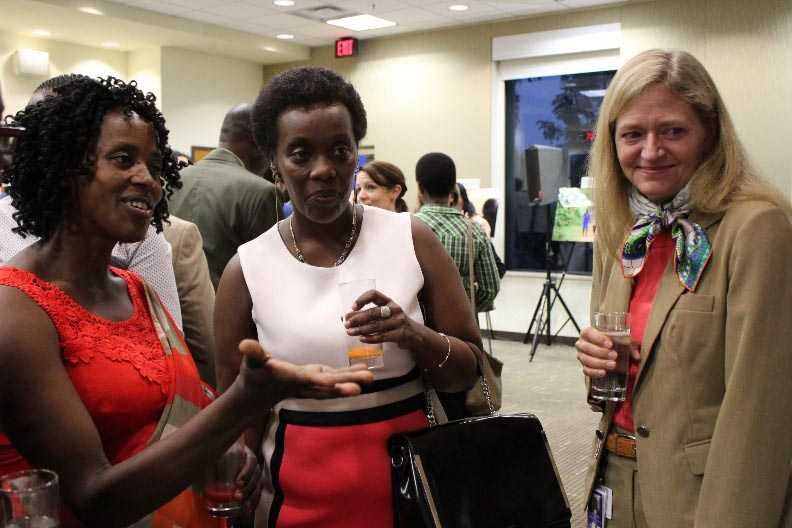Rwanda One of the First Countries to Launch the Differentiated HIV Care Model Nationally
By CDC Rwanda and MSG Rwanda Interagency Team

'Jacqueline' explains one of the photos to Ambassador Barks-Ruggles and Hon. Minister Gashumba during the HIV partnership event. Photo Courtesy of W. Herkewitz/USAID Rwanda.
The Government of Rwanda (GOR) successfully launched the national Differentiated Service Delivery Model (DSDM) for HIV/AIDS treatment and service provision on December 1, 2016, at a national event marking World AIDS Day. The DSDM, also known as differentiated care, aims to increase capacity to provide HIV care and treatment to all patients, while focusing more intensive services towards higher-risk HIV patients and reducing the frequency of routine healthcare visits for stable, low-risk HIV patients. Differentiated care is a patient-centered approach that aims at focusing HIV care and treatment services on high-risk patients who need it the most. In FY17, the U.S. Government (USG), through PEPFAR, gave close to 20 million U.S. dollars in support of Rwanda’s national DSDM rollout.
It took the GOR about 5 months to plan the logistics, train relevant staff, prepare health facilities, and launch the DSDM nationally. This is a tremendous testament to the level of commitment from the Ministry of Health (MOH) and Rwanda Biomedical Center (RBC) staff as well as from the CDC staff who serve as co-chairs on the Technical Working Group, which was responsible for overseeing the planning and implementation of the DSDM. Given that Rwanda is one of the first countries to implement the DSDM on a national scale, the CDC, in collaboration with the RBC, has developed a protocol to support enhanced monitoring and evaluation of the model’s implementation at health facilities in Rwanda to ensure timely identification and remediation of challenges, programmatic improvement, and documentation of best practices for replication in other countries.
The DSDM is built on the existing HIV clinical services model but tailors services to patients’ needs. Under this new model, HIV patients are categorized under two broad groups: stable and unstable. Both groups receive comprehensive care and treatment services but with varying frequency. Stable patients have been on antiretroviral therapy for at least 18 months with good adherence, have no pre-existing conditions, and have suppressed viral loads. In Rwanda, most of the HIV patients receiving care and treatment meet the definition of stable. Unstable patients are patients who started treatment less than 18 months ago, have unsuppressed viral loads, are children under 15 years old, have other chronic conditions, or are pregnant.
Under the DSDM, stable patients move from monthly to quarterly visits for prescription drug pick-up and from quarterly to biannual clinic visits. By spending less time with low-risk, stable patients, health providers can focus care and treatment efforts on higher-risk patients and new patients. Stable patients will also spend less time and money traveling to healthcare facilities, since visits are spaced further apart.
CDC staff were instrumental in supporting the Rwandan MOH to develop the clinical definitions for stable and unstable patients, revise the National HIV Guidelines, and develop a monitoring and evaluation framework for the DSDM.
There are many lessons to be learned from Rwanda’s national implementation of the DSDM. The first two years of the DSDM implementation are critical. CDC, in collaboration with the MOH and its key partners, developed a monitoring and evaluation protocol for the DSDM in Rwanda. The aim of the protocol is to allow for timely identification and remediation of challenges, promote program improvement, and document best practices. USAID staff were instrumental in developing a resupply calculator to ensure accurate quantities of HIV drugs and commodities are ordered for both district pharmacies and service delivery points. Furthermore, USAID supported MOH to develop an initial distribution plan by determining required quantities for each district pharmacy and their associated service delivery points.
The U.S. Ambassador to Rwanda, Erica Barks-Ruggles, hosted all the USG’s principal HIV/AIDS partners in Rwanda at a reception and photo exhibition to commemorate both the national rollout of the DSDM and over a decade of successful partnership in the fight against HIV/AIDS. The Minister of Health, Dr. Diane Gashumba, attended as the guest of honor and delivered remarks where she stressed the importance of the USG’s partnership in helping Rwanda achieve an AIDS-free generation by 2020. Ambassador Barks-Ruggles reminded those present that the successful roll-out of DSDM was just one example of the recent work done together to ensure Rwanda reaches epidemic control. She emphasized the need for all partners to recommit to helping dismantle the stigma and discrimination that threaten key affected populations so that every Rwandan can access the HIV prevention and treatment services they need. The event was attended by over 90 government officials, bilateral and multilateral partners, nongovernmental organization leaders, civil society members, and notable PEPFAR program beneficiaries.
The CDC and USAID’s focused, committed support and technical assistance to the GOR, through PEPFAR, has made it possible for Rwanda to nationally implement the DSDM, becoming among the first countries in Africa to do so. The USG, through PEPFAR and the CDC and USAID, is committed to supporting Rwanda to effectively monitor and document the national implementation of the DSDM so other countries can learn from their experience.
- Page last reviewed: March 1, 2017
- Page last updated: March 1, 2017
- Content source:
Global Health
Notice: Linking to a non-federal site does not constitute an endorsement by HHS, CDC or any of its employees of the sponsors or the information and products presented on the site.


 ShareCompartir
ShareCompartir